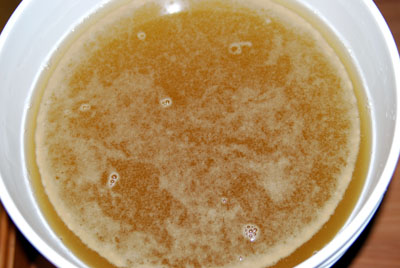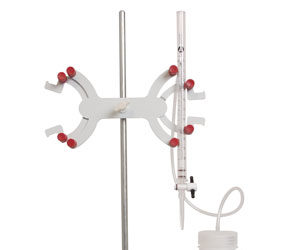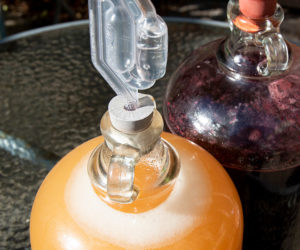 Fermentation is a chemical reaction that takes place when yeast turns sugar into carbon dioxide and alcohol.
Fermentation is a chemical reaction that takes place when yeast turns sugar into carbon dioxide and alcohol.
Obviously, this is a critical part of the entire process. A yeast cell will turn approximately 55% of the sugar it eats into ethyl alcohol, and the remaining 45% into carbon dioxide gas and other byproducts. The proportion is not exact since some sugar is consumed by the yeast, and some converted to acids, esters and aldehydes. You can ferment just about anything on this planet, if sugar is present. But all fermentation, including what takes place in your must, requires yeast: a one-celled living organism. It eats, reproduces and gives your wine life.
Fermenting the Wine
Now that we’ve covered the vital elements, we can walk through a chronological model of the entire process from pitching yeast to aging.
Day 1: Grapes and Fresh Juice
The first time I bought grapes I was surprised at all the extra stuff that came with my purchase: spiders, twigs, leaves, flies and other no-see-um single-celled creatures. Fruit flies carry acetobacter bacteria. This bacteria converts alcohol to acetic acid, giving wine acetic astringency, or a vinegar taste. Another enemy is oxygen. Ever bite an apple and leave it sitting? Notice how it turns brown? Enzymes in fruit, once activated in air, turn fruit brown. The trick is to remove oxygen. The solution: potassium metabisulfite. Potassium metabisulfite produces sulfur dioxide in your must (free SO2). When used in correct proportions it stuns indigenous yeasts, kills bacteria and prevents grapes from oxidizing.
Now that you’ve subdued the three enemies of wine, take a specific gravity reading with your sanitized hydrometer to determine your sugar level and potential alcohol. Hopefully, your specific gravity will be around 1.090. That’s about 12.2% potential alcohol. If the SG is less than 1.090 you might want to consider chaptalization (adding sugar) to give your yeast more to eat, and therefore produce more alcohol. If you find that the Brix level of your must is too high (say up around 1.100), consider diluting it. Add water a bit at a time, taking readings.
Sterile juice, unlike crushed grapes, does not need to be sulfited; the supplier will have done all that for you. Some proprietors will even give you the SG, pH and Brix reading for your crushed grapes or juice. Even so, double-check it at home to determine if adjustments are needed. The ideal is 0.6 to 0.8% acid for reds, and 0.65 to 0.85% for whites. With a pH meter, look for a pH of 3.1 to 3.2 in reds and 3.4 for whites.
Pitching Yeast
There are various ways to pitch yeast, depending on whether it is dry or liquid. Dry yeast offers two ways. One: Lift the lid, sprinkle the yeast on top of your must, lower the lid and walk away. As long as the must temperature is in the low 70s °F (low 20s °C), it works.
Two: The most reliable method is rehydration. Sprinkle the yeast into a quarter cup of water warmed to 95 °F (35 °C) (no higher); in 10 minutes you’ll see the rehydrating yeast swell to a paste. Mix it into your batch. Rehydration guarantees your yeast is alive and when you pour it into your must it hits the ground running. Don’t let the yeast-water stand longer than 15 minutes; without sugar it will starve.
Instructions for preparing liquid yeast vary according to the manufacturer. Some cultures need to be incubated from 1 to 5 days before pitching. Other liquid cultures come in vials that can be added immediately.
For the first 12–24 hours after pitching the yeast, you may notice zero activity. Not to fret. Your little yeast buddies are in there, multiplying like there’s no tomorrow. Monitor your must temperature and give it a day.
Yeast Nutrients
Besides sugar, yeast needs potassium, iron, calcium, vitamin B, B1, copper, lead, zinc and other minerals. If your must lacks nutrients, you might consider adding them. Winemakermag.com offers a plethora of information on the subject. Just type “yeast nutrient” into the search engine.
Day 2–5
With juice wines, day five is a good time to rack your fermenting wine off the sediment into carboys. Racking when the SG drops to 1.020 and the vigor of fermentation has subsided is a suggested practice. This is usually around day five. Note: Keep the end of your racking tube submerged to retain a protective layer of carbon dioxide on your wine.
Batch Sizes and Carboys
The right size and type of carboy is key. After primary fermentation, fresh or sterile juice that’s sold in 5-gallon (19-L) pails should be racked to a 5-gallon (19-L) carboy. During fermentation the layer of CO2 on your wine will protect it. When fermentation is complete, top up within 2 inches of the bung. A sulfite solution in the airlock will block fruit flies and other organisms.
Day 10–17
The airlock will work regularly, releasing carbon dioxide gas as fermentation slows over the next days or weeks. When the SG bottoms out between 0.995 and 0.990 and remains there for about three days you can conclude that fermentation is over.
Fining
Fining is the act of adding a suitable “fining agent” such a gelatin, that will stick to suspended particles in your wine and pull it to the bottom. Whether you prefer to filter or fine your wine is a personal preference. The vast majority of wines you buy are filtered or fined or both. If you choose not to filter or fine you wine, aged bottles will gather sediment over time. If you don’t mind decanting your wine before serving it, then this is an acceptable alternative. For wines from juice or grapes there are various types of fining agents on the market: Isinglass (made from the bladder of fish, in liquid or powder); bentonite (clay); Sparkolloid (powdered polysaccharide extracted from brown algae), and Kieselsol (a liquid in which small silica particles are suspended).
Stabilizing
Stabilizing ensures that no fermentation will happen again. It also protects your wine against spoilage organisms and oxidation. Some home winemakers prefer not to stabilize. This also is a personal preference. While new, unstabilized wine can be enjoyable, your wine will have no immune system and will not last long.
The method of stabilizing your wine will probably be during your second (or third) racking after fermentation is complete. There are two ingredients to stabilize wine. One is potassium metabisulfite. For healthy wine, it is recommended you maintain 30 ppm of free SO2. For this you need to measure how much free SO2 you already have. To stabilize, draw a cup of wine from your carboy, dissolve your potassium metabisulfite crystals (or crushed tablets) and add it to your wine. If stabilizing during racking, pour the dissolved solution on the bottom of the receiving carboy so that the wine will immediately be protected during transfer. Keep the end of your racking tube submerged.
The second ingredient is potassium sorbate, which prevents residual yeast cells from multiplying. Sorbate is not typically necessary in dry wines. If, however, there is residual sugar above 0.995, sorbate is recommended. Half to one teaspoon of potassium sorbate for every 6 gallons (19 L) will work.






